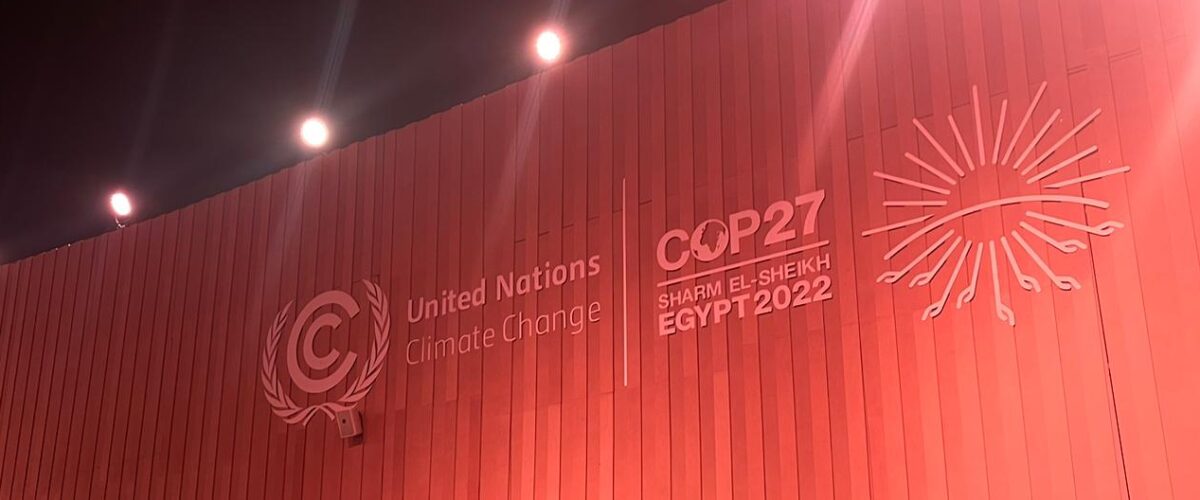Every year, the Conference of the Parties (COP), hosted by the United Nations Framework Convention on Climate Change (UNFCCC), brings together world leaders to align on policies to limit global temperature rise and mitigate the worst impacts of climate change. This year’s 27th summit took place in November in the city of Sharm El-Sheikh, Egypt, filled with representatives from a broad spectrum of sectors worldwide sharing their intentions, ideas, and innovative progress.
COP27’s immense size and scope have left the global environmental community wondering whether the conference’s original objective -to holistically address and mitigate climate change- is still realistic. Are COP’s formal, high-level negotiations aligned with the realities currently faced by climate-vulnerable communities around the world, especially considering the pace of innovation and mobilization required to address these adversities? This was one of the questions we pondered during COP27. In this blog, we will share some of the key moments and meaningful takeaways from the conference.

In November, our Director of Business Partnerships for EMEA, Stein Haugan, attended the 27th summit in the city of Sharm El-Sheikh, in Egypt.
Walking the Talk for Urgent Climate Change at COP27
As the war rages on in Ukraine, we are simultaneously experiencing spiking inflation, a sinking economy, and volatile energy prices—all of which are influenced and exacerbated by each other. Meanwhile, climate change is driving record-high temperatures, extreme weather events, and sea level rise around the world. How can global leaders and policymakers address any or all of these problems in the short period of time available? Below, we review some of the key developments coming out of COP27 that are helping to make inroads during this extremely tumultuous time.
UN Establishes Fund for “Loss and Damages”
The expectation coming into COP27 was that negotiations would focus on climate financing, adaptation, and, most crucially, establishing a fund to pay for climate “loss and damages” to developing countries. Small island states and other vulnerable nations, which have and will continue to experience substantial climate-related damages despite contributing relatively little to global climate change, have long advocated for such a fund. This call lent increased urgency following the devastating flooding experienced by Pakistan and Nigeria earlier this year.
Although parties have struggled to find consensus on loss and damages in the past, COP27 saw a breakthrough after the EU proposed (and the U.S. eventually agreed to) the creation of a joint fund to compensate for climate damages. We await more substantive details of this fund next year and at future COPs.
Support for Adaptation Efforts in Developing Countries
Financing for adaptation in the Global South was another major focus of conversation at COP27. Adaptation finance provides countries with proactive support to help build climate resilience before disasters strike. Nations formally committed to finalizing the UN’s Global Goal for Adaptation next year at COP28 but, in the meantime, have pledged an additional $230 million to the Adaptation Fund.
Furthermore, the UN announced the launch of its Early Warnings for All initiative, which aims to provide all individuals in the Global South with early warning signals for extreme weather events and impending climate disasters. The UN’s Race to Resilience campaign also released a new Data Explorer intended to transparently track national progress toward adaptation implementation.
Expert Group Pushes to Standardize Net Zero Target-Setting
The UN High-Level Expert Group on Net Zero Commitments (HLEG) released a Net Zero Commitments report that attempts to establish a “universal definition of net zero” through 10 key recommendations on target-setting, use of carbon credits, reporting, and climate advocacy.
U.S. Strengthens Commitment to Climate Action
The U.S. reaffirmed its commitment to climate change mitigation at COP27, introducing new regulations and initiatives intended to cut greenhouse gas emissions both domestically and abroad:
![]() Methane reductions: President Joe Biden announced plans to strengthen methane regulations in the oil and gas sector to cut emissions by 87% below 2005 levels by 2030.
Methane reductions: President Joe Biden announced plans to strengthen methane regulations in the oil and gas sector to cut emissions by 87% below 2005 levels by 2030.
![]() Energy Transition Accelerator: A new carbon market mechanism that will allow companies to fund jurisdictional-scale transitions away from coal and oil in developing economies in return for “offsets” from resulting greenhouse gas reductions.
Energy Transition Accelerator: A new carbon market mechanism that will allow companies to fund jurisdictional-scale transitions away from coal and oil in developing economies in return for “offsets” from resulting greenhouse gas reductions.
![]() Climate Targets for Federal Suppliers: The U.S. became the first nation to require federal government suppliers to set Paris Agreement–aligned emission reduction goals through its Federal Supplier Climate Risk and Resilience Rule.
Climate Targets for Federal Suppliers: The U.S. became the first nation to require federal government suppliers to set Paris Agreement–aligned emission reduction goals through its Federal Supplier Climate Risk and Resilience Rule.
Small Steps Lead to Small Ambitions at COP27
While COP27 generated a number of positive outcomes, the conference failed to address a few crucial issues to avoid the most catastrophic effects of climate change. Some of the barriers that emerged during COP27 are detailed below.
Failure to Formally Commit to Fossil Fuel Phase-Out
Despite progress in providing financial support for developing countries, there were few efforts in formal negotiations to strengthen emission mitigation efforts and targets. Notably absent from the overarching COP27 decision (dubbed the “Sharm el-Sheikh Implementation Plan”) was language around phasing out fossil fuels, despite calls to include such language from many nations, including the U.S. and India. This failure to increase ambition left observers questioning if the Paris Agreement’s goal of limiting warming to 1.5 degrees Celsius is still within reach.
EU Unsuccessfully Pushes for Increased Mitigation Ambition
Yet again, and not surprisingly, the EU led the global community on climate change mitigation, driving breakthrough negotiations on loss and damages under the condition that all other nations commit to strengthening their emissions targets. While their push to increase global mitigation action ultimately failed, the EU was one of the only negotiating parties to announce a plan to update its own climate goal by pledging 55% emissions reductions by 2030, supported by the REPowerEU initiative.
Final Remarks
While there were hundreds of other announcements at COP27, the time to act is shrinking, and positive reinforcement will be crucial in the long run. Encouragingly, many organizations and companies gathered to bring constructive and promising solutions to pressing climate problems. Ultimately, governments, companies, and individuals must work together to protect the same and only planet Earth we all share.
Reach out to discuss how your company can mitigate its impact on climate change.

Maggie Lund, Policy Manager, Carbon Markets & Corporate Carbon Strategies
Maggie leads 3Degrees’ carbon-related policy engagement, working directly with standard-setters and regulatory authorities to develop best practice recommendations for international carbon markets.

Stein Haugan, Director of Business Partnerships, Renewable Energy & Climate, EMEA
Stein supports global corporate customers to deliver renewable energy and carbon solutions tailored to their specific sustainability goals.


